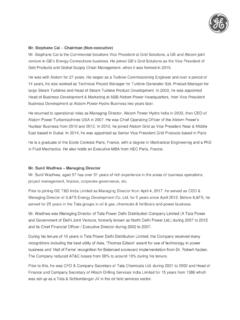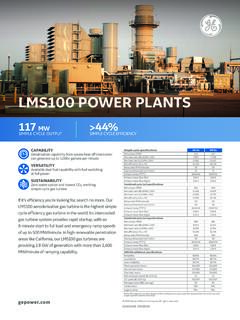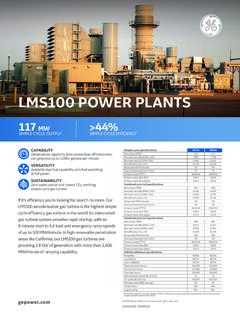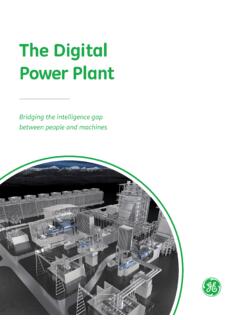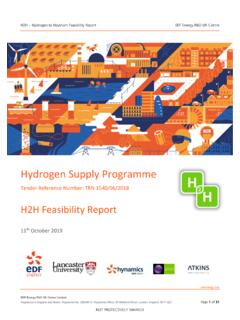Transcription of Hydrogen as a fuel for gas turbines - GE.com
1 Hydrogen as a fuel for gas turbinesA pathway to lower CO2 as a fuel for Gas Turbines2 The power sector s journey to decarbonize, often referred to as the Energy Transition, is characterized by rapid deployment of renewable energy resources and a rapid reduction in coal, the most carbon-intensive power generation source. Based on our extensive analysis and experience across the breadth of the global power industry, GE believes that the accelerated and strategic deployment of renewables and gas power can change the near-term trajectory for climate change, enabling substantive reductions in emissions quickly, while in parallel continuing to advance the technologies for near zero-carbon power generation. Part of this deployment of gas power may involve the use of Hydrogen as a fuel in order to reduce CO2 of 2020 there were ~1,600 GW of gas turbines installed globally, and gas power accounted for ~22 percent of global electricity generated. The vast majority of gas turbines burn natural gas, or methane (CH4), to release energy which ultimately produces the electricity we use at home, schools, factories, in the community and for are two ways to systematically approach the task of turning high efficiency gas generation into a zero or near zero-carbon resource: pre and post-combustion.
2 Pre-combustion refers to the systems and processes upstream of the gas turbine and post-combustion refers to systems and processes downstream of the gas turbine . The most common approach today to tackle pre-combustion decarbonization is simple: to change the fuel , and the most talked about fuel for decarbonization of the power sector is is a world leader in gas turbine fuel flexibility, including more than 100 gas turbines that have (or continue to) operate on fuels that contain Hydrogen . This fleet has accumulated more than 8 million operating hours and produced more than 530 Terawatt-hours of electricity. It includes a group of more than 30 gas turbines that Executive SummaryIn order to combat man-made climate change, there is a global need for decarbonization,* and all sectors that produce carbon dioxide (CO2) must play a believes that using Hydrogen as a fuel is one of the potential ways to decarbonize gas power generationhave operated on fuels with at least 50% (by volume) Hydrogen .
3 These units have accumulated more than million operating hours, giving GE a unique perspective on the challenges of using Hydrogen as a gas turbine is continuing to advance the capability of its gas turbine fleet to burn Hydrogen through internally funded R&D programs and through US Department of Energy funded programs. The goals of these efforts are to ensure that ever higher levels of Hydrogen can be burned safely and reliably in GE s gas turbines for decades to come.* Decarbonization in this paper is intended to mean the reduction of carbon emissions on a kilogram per megawatt hour as a fuel for Gas Turbines3 FIGURE 1: Means of decarbonizing a gas turbineIntroductionFigure 1 depicts the two methods for decarbonizing a gas turbine : pre and post-combustion. For pre-combustion decarbonization a fuel such as Hydrogen containing no carbon or a carbon neutral fuel such as biogas is burned in the gas turbine . GE gas turbines have a long history of burning fuels ranging from Hydrogen , to natural gas and high molecular weight hydrocarbons, to diesel fuel , to crude oil.
4 Each fuel has unique post-combustion decarbonization, there is a tool chest of different technologies that can remove CO2 from the flue gases with the most common being in a process referred to as carbon capture. The general concept of carbon capture involves introducing a specialized chemical which has an affinity to carbon into the plant exhaust stack. Once the CO2 and the chemical bond, the compound is taken to a separate vessel and separated into its constituents. The resulting pure CO2 is taken to a compression tank and is ready for transportation. This CO2 is then transported to either a geologic formation deep underground for permanent storage, or re-used in industrial processes, thus completing the process of Carbon Capture and Utilization or Sequestration (CCUS).It s important to note that pre and post-combustion decarbonization approaches can be employed on existing installed gas turbines as a retrofit or included in the design of a new power plant, avoiding the potential lock-in of CO2 emissions for the entire life of the power INFRASTRUCTURE PRODUCTION, TRANSPORT, AND STORAGEH ydrogen is the most abundant element in the universe, but despite its plentiful nature it does not exist on earth as a standalone molecule.
5 In other words, Hydrogen likes to bond with other molecules. In order to yield pure Hydrogen , it must be separated from its paired molecules, usually found in the form of water (H2O), or hydrocarbons ( , CH4). More than 90% of the Hydrogen produced globally today uses natural gas or USE A ZERO OR CARBON NEUTRAL fuel Hydrogen (blue, green, pink) Synthetic (renewable) methane Biofuels Ammonia (NH3)REMOVE CARBON FROM THE PLANT EXHAUST Carbon capture (liquid solvents) Carbon capture (solid sorbents) Oxy- fuel cyclesPRE-COMBUSTIONPOST-COMBUSTION coal as a feedstock, typically in a process called steam methane reforming (SMR). The SMR process produces CO2 as a by-product and most of this CO2 is released to the atmosphere. An alternative method of producing Hydrogen is through electrolysis in which a water molecule is broken into its Hydrogen and oxygen constituents by passing electricity through the water. No CO2 is produced directly by the electrolysis process, but depending on the fuel source of the electricity, CO2 could be color-based convention is being used internationally to describe and differentiate Hydrogen production methods: Grey (or black): Gasification of coal or reforming of natural gas without carbon capture Blue: reforming of methane (SMR) with carbon capture and storage Green: Electrolysis of water using renewable power Pink (Red): Electrolysis of water using nuclear power Turquoise: Pyrolysis of methane which produces Hydrogen and solid carbon as a by-product White: Gasification or other process using 100% biomass as a feedstockThe cost of Hydrogen produced by these different methods can vary widely, with grey (or black) typically being the least expensive.
6 The price for Hydrogen produced using the electrolytic processes ( , green, pink, red) depends primarily on the cost of the electricity used in the process and the utilization rate, or capacity factor of the electrolyzers. A higher capacity factor tends to result in lower Hydrogen costs, all other factors being equal. Gas turbines are capable of operating on Hydrogen from any of the previously described sources. Transporting and storing Hydrogen requires special considerations due to its property of attacking and embrittling certain materials and the extreme pressures and temperatures needed to compress and liquefy it. Hydrogen embrittlement occurs when Hydrogen atoms diffuse into a base material and disrupt the microscopic structure of the material that provides its strength. Some stainless steels offer increased Hydrogen embrittlement resistance, but at a higher cost than the carbon steels typically used for transporting natural is typically compressed to between 35 to 150 bar (~500 to ~2,200 psi) for pipeline transmission whereas the distribution system that provides gas to many end users typically operates at pressures less than ~7 bar (~100 psi).
7 For storage, Hydrogen is typically compressed to more than 350 bar (~5,000 psi. Hydrogen storage and transmission systems may require specialized high-pressure equipment and will require a significant amount of energy for compression. Liquefying Hydrogen is even more of a challenge because it condenses from a gas into a liquid at less than -250 C (~-420 F), requiring a significant Hydrogen as a fuel for Gas Turbines4 CONSIDERATIONS FOR USING Hydrogen AS A GAS turbine FUELThe basic configuration of a gas turbine capable of burning natural gas would remain unchanged for burning Hydrogen . Specific areas that need to be addressed within the gas turbine , its accessory systems, and the plant itself include: 1) fuel delivery piping and components, 2) gas turbine combustion system and controls, 3) gas turbine enclosure, and 4) the heat recovery steam generator (HRSG) and selective catalytic SCRGas turbine combustion systemHRSGGas turbine enclosure modifications: ventilation, hazardous gas detection, fire protectionFuel accessory system: skids, valves, piping, purge systemsGas turbine controlsHydrogen has different properties than methane .
8 Operating a gas turbine on a fuel with Hydrogen may require changes to combustion, fuel , and plant safety (SCR) system for NOX removal. Control of NOX is important because in most jurisdictions it is a regulated pollutant that if unabated contributes to smog, acid rain, and ozone has a heating value that is approximately one-third of natural gas. This means that for a given volume of flow, Hydrogen delivers less energy. It is also a smaller molecule than natural gas, meaning that it can leak through seals that would be leak-free in a natural gas system. If a Hydrogen /natural gas fuel blend with a relatively low concentration of Hydrogen is used, the existing fuel delivery system may be adequate, but at higher concentrations of Hydrogen , larger fuel delivery system components with materials not susceptible to Hydrogen embrittlement, and welded seals may be flame speed of Hydrogen is an order of magnitude faster than natural gas. This is an important consideration for the safe and reliable operation of the combustion system.
9 A higher flame speed could result in the flame in the combustor propagating upstream too far, resulting in a condition called flashback that can cause combustion hardware damage. Combustor configuration changes and associated turbine control system changes may be needed to operate with high concentrations of Hydrogen fuel . Hydrogen is more flammable than natural gas and special considerations are needed for the safe operation of a gas turbine with a natural gas/ Hydrogen fuel blend. The gas turbine enclosure and ventilation system need to be designed to ensure the concentration of Hydrogen is maintained outside of its upper and lower explosive limits. Hazardous gas and flame detection systems configured for typical hydrocarbon fuels may need to be supplemented with systems capable of detecting 2:Systems that may require modification when using Hydrogen fuelamount of energy for cooling the gas to this temperature, and special double-walled cryogenic tanks for storage.
10 The largest tank of this kind in the world is located at NASA s Kennedy Space Center and stores approximately million litres (~850,000 gallons) of liquid Hydrogen . This amount of fuel would be consumed in a GE gas turbine rated at 430 MW in about 8 as a fuel for Gas Turbines5 The flame temperature of Hydrogen is higher than natural gas. This could result in an increase in NOX emissions depending on the concentration of Hydrogen in the fuel and the specific combustion system in the gas turbine . GE combustion studies indicate a 50/50 mixture by volume of Hydrogen /natural gas could increase the concentration of NOX in the gas turbine exhaust by 35 percent. For a plant under development this may require a larger or more efficient SCR system. For existing power plants, there may be some ability to accept increases in NOX emissions based on existing SCR capabilities (if installed), and the plant s air permit limits. Another mitigant could be to derate the power plant to maintain operation within the existing air permit s NOX emission additional consideration when blending Hydrogen with natural gas as a fuel for gas turbines is that there is not a 1:1 relationship between the volume of Hydrogen in the fuel and the CO2 emissions reduction achieved.



